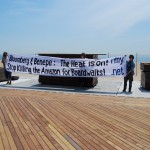Protesters take a stand at the Coney Island Boardwalk
May 1, 2010: Members of Rainforest Relief and the New York Climate Action Group slipped inside the construction site at the legendary Boardwalk in Coney Island, just east of Stillwell Avenue. Here, bundles of tropical hardwoods are being screwed to the newly-renovated section of the Boardwalk. The protesters unfurled a banner reading, “Bloomberg and Benepe: The Heat Is On; Stop Killing the Amazon for Boardwalks; rfny.net.” According to the groups, New York City Parks Department has lied about the wood being ‘sustainable’ and also gone back on the agency’s commitment to phase out the use of tropical hardwoods.
According to Rainforest Relief (RR), New York City is the single largest consumer of tropical hardwoods in North America. The group has worked to compel the city to end its use of these woods for years. In December, 2007, Bloomberg called for a plan to reduce the City’s use of these woods at the climate talks in Bali, Indonesia. In a speech at the UN the following February, he announced the Tropical Hardwood Reduction Plan, which promised to cut the City’s use of tropical hardwoods by 60% by 2020. The Plan states, “It is possible, as some have alleged that NYC is one of the leading consumers of tropical hardwoods in the nation.”
Tropical hardwoods used for City infrastructure include twelve miles of boardwalks; tens of thousands of benches, the decking of the Brooklyn Bridge, South Street Seaport, Fulton Ferry Terminal and Empire-Fulton State Park; hundreds of miles of subway track ties, and the fendering and thousands of pilings in the Staten Island Ferry terminals.
The wood being laid down on the boardwalk is called cumaru. Signs about the upcoming renovations posted by Parks along the boardwalk state that the wood would be ‘sustainable’.
But cumaru trees are scattered at an average of one to two per acre in the old-growth Amazon rainforests of Brazil and Peru. Loggers typically bulldoze a network of roads and trails to access these high-value trees. According to one study, on average, 28 other trees are killed to access the single targeted tree. Once there, the roads most often spell the final doom of the logged forest. According to the UN Food and Agriculture Organization, 70% of deforestation due to clearing for agriculture is precipitated by the presence of logging roads. This deforestation — mostly in the tropics — is responsible for 25 – 30% of human-caused greenhouse gas emissions.
“Calling this wood ‘sustainable’ is simply a lie,” said Tim Keating, Rainforest Relief’s Executive Director. “There’s no such thing as sustainable when it comes to logging in old-growth rainforests.”
“You can’t call yourself the Green Mayor while you’re playing Three-card Monte with the world’s climate,” said JK Canepa, co-founder of NYCAG.
Other environmentally preferable alternatives are readily available. Recycled plastic lumber will last 5 times longer than cumaru. In fact, new boardwalk renovations are using concrete beneath the decking, partly to utilize recycled plastic. Yet, in the case of Coney Island, for no practical purpose, the decision was made to use rainforest wood for the decking yet again.
